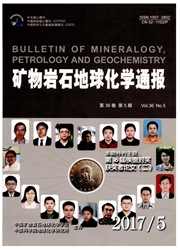

 中文摘要:
中文摘要:
原始定义的埃达克岩是钠质火成岩,其全岩化学成分相当于英云闪长岩、奥长花岗岩和(富斜长石的)花岗闪长岩(TTG);而富钾的"C型埃达克岩"全岩化学成分相当于(狭义)花岗岩、石英二长岩和(富碱性长石的)花岗闪长岩。现有的失水部分熔融实验岩石学表明,中等富钾程度的贫硅(高Mg#值)玄武质源岩的低比例部分熔融条件下可以形成酸性"C型埃达克岩";玄武质源岩部分熔融不会形成那些SiO2含量中等而又不具备高度富碱特征的"C型埃达克岩"。高Sr低Y特征并非判别"C型埃达克岩"高压(p≥1.5 GPa)熔融成因的决定性标志,仅仅基于高Sr低Y特征而认为"C型埃达克岩"形成于高压熔融的成岩机制是值得商榷的。
 英文摘要:
英文摘要:
The original defined adakites are sodic igneous rocks,they are tonalite,trondhjemite or(plagioclase-rich) granodiorite in whole-rock chemistry;however,the K-rich "C-type adakites" defined by Chinese scholars are potassic igneous rocks,they belong to granite(s.s.),quartz monzonite and(alkali feldspar-rich) granodiorite,etc.The fluid-absent melting experiments indicate that the acid "C-type" adakite can be generated by low portion melting of the basaltic source-rock that has intermediate potassic and low silicic contents(or high Mg#) under higher pressure.Otherwise,these experiments do not support the assumption that the intermediate "C-type" adakite,which does not have high alkali contents,is originated from the melting of basaltic source-rock.The characteristics of high Sr and low Y is not a key proxy to indicate the high pressure(p≥1.5 GPa) melting origin of "C-type adakites".Accordingly,it is not properly to assume the high pressure melting regime for "C-type adakites" just based on the high Sr and low Y characteristics.
 同期刊论文项目
同期刊论文项目
 同项目期刊论文
同项目期刊论文
 Style of deep faulting and its control on the Paleogene basin evolved into the western Huimin depres
Style of deep faulting and its control on the Paleogene basin evolved into the western Huimin depres P-T paths derived from garnet growth zoning in the Danba domal metamorphic terrain, Sichuan Province
P-T paths derived from garnet growth zoning in the Danba domal metamorphic terrain, Sichuan Province Early Cretaceous extensional structures in the Liaodong Peninsula: structural associations, geochron
Early Cretaceous extensional structures in the Liaodong Peninsula: structural associations, geochron Geology of the Sandaowanzi telluride gold deposit of the northern Great Xing'an Range, NE China: Geo
Geology of the Sandaowanzi telluride gold deposit of the northern Great Xing'an Range, NE China: Geo Zircon SHRIMP U-Pb age of Yinmawanshan and Zhaofang pluton in South Liaoning metamorphic core comple
Zircon SHRIMP U-Pb age of Yinmawanshan and Zhaofang pluton in South Liaoning metamorphic core comple Formation and timing of the extensional ductile shear zones in Yiwulü mountain area, Western Liaonin
Formation and timing of the extensional ductile shear zones in Yiwulü mountain area, Western Liaonin New Geochronological Data from the Paleozoic and Mesozoic Nappe Structures, Igneous Rocks, and Molyb
New Geochronological Data from the Paleozoic and Mesozoic Nappe Structures, Igneous Rocks, and Molyb 期刊信息
期刊信息
